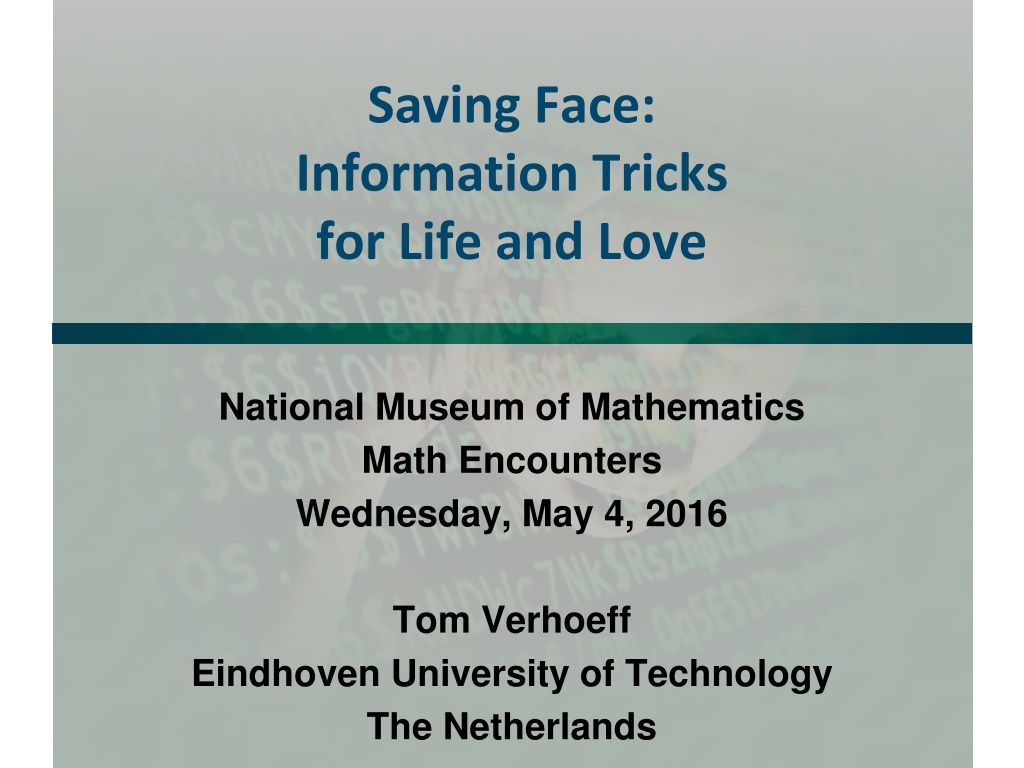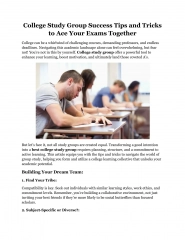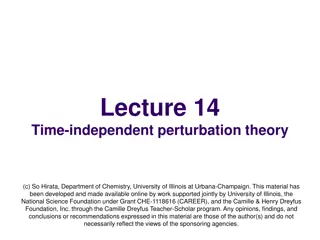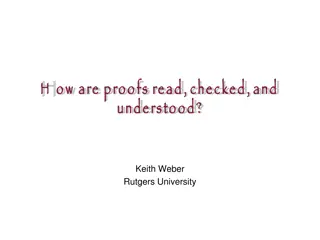Information Theory and Mathematical Tricks
Exploring information theory with mathematical tricks performed by Tom Verhoeff at the National Museum of Mathematics. Topics include communication, storage of information, measuring information, and the use of playing cards in magical tricks to demonstrate mathematical principles.
Download Presentation

Please find below an Image/Link to download the presentation.
The content on the website is provided AS IS for your information and personal use only. It may not be sold, licensed, or shared on other websites without obtaining consent from the author.If you encounter any issues during the download, it is possible that the publisher has removed the file from their server.
You are allowed to download the files provided on this website for personal or commercial use, subject to the condition that they are used lawfully. All files are the property of their respective owners.
The content on the website is provided AS IS for your information and personal use only. It may not be sold, licensed, or shared on other websites without obtaining consent from the author.
E N D
Presentation Transcript
Saving Face: Information Tricks for Life and Love National Museum of Mathematics Math Encounters Wednesday, May 4, 2016 Tom Verhoeff Eindhoven University of Technology The Netherlands
Any-Card-Any-Number (ACAN) Trick 1 volunteer 27 playing cards 1 magician 3 questions
A Mathematical Theory of Communication Shannon (1948): The fundamental problem of communication is that of reproducing at one point either exactly or approximately a message selected at another point.
Setting for Information Theory Sender Channel Receiver Storer Memory Retriever Problem: Communication and storage of information Compression for efficient communication 1. Protection against noise for reliable communication 2. Protection against adversary for secure communication 3.
How to Measure Information? (1) The amount of information received depends on: The number of possible messages More messages possible more information The outcome of a dice roll versus a coin flip
How to Measure Information? (2) The amount of information received depends on: Probabilities of messages Lower probability more information
Quantitative Definition of Information Due to Shannon (1948) Let P(A) be the probability of answer A: 0 P(A) 1 (probabilities lie between 0 and 1) (probabilities sum to 1) Amount of information (measured in bits) in answer A:
Five-Card Trick 1 assistant 52 playing cards 1 magician 5 selected cards
How Does it Work? Use four face-up cards to encode the face-down card Pigeonhole Principle: 5 cards contain a pair of the same suit One lower, the other higher (cyclicly) Values of this pair differ at most 6 (cyclicly) Encoding of face-down card Suit: by suit of the rightmost face-up card Value: by adding rank of permutation of middle 3 cards There are 3! = 3 x 2 x 1 = 6 permutations of 3 cards
Shannons Source Coding Theorem (1948) Sender Encoder Channel Decoder Receiver There is a precise limit on lossless data compression: the source entropy Entropy H(S) of information source S: Average amount of information per message Modern compression algorithms get very close to that limit
Number Guessing with Lies Also known as Ulam s Game Needed: one volunteer, who can lie
The Game Volunteer picks a number N in the range 0 through 15 (inclusive) 1. Magician asks seven Yes No questions 2. Volunteer answers each question, and may lie once 3. Magician then tells number N, and which answer was a lie (if any) 4. How can the magician do this?
Question Q1 Is your number one of these: 1, 3, 4, 6, 8, 10, 13, 15
Question Q2 Is your number one of these? 1, 2, 5, 6, 8, 11, 12, 15
Question Q3 Is your number one of these? 8, 9, 10, 11, 12, 13, 14, 15
Question Q4 Is your number one of these? 1, 2, 4, 7, 9, 10, 12, 15
Question Q5 Is your number one of these? 4, 5, 6, 7, 12, 13, 14, 15
Question Q6 Is your number one of these? 2, 3, 6, 7, 10, 11, 14, 15
Question Q7 Is your number one of these? 1, 3, 5, 7, 9, 11, 13, 15
How Does It Work? Place the answers ai in the diagram Yes 1, No 0 a1 For each circle, calculate the parity Even number of 1 s is OK Circle becomes red, if odd a5 a3 a7 a4 a6 a2 No red circles no lies Answer inside all red circles and outside all black circles was a lie Correct the lie, and calculate N = 8 a3 + 4 a5 + 2 a6 + a7
Hamming (7,4) Error-Correcting Code 4 data bits To encode number from 0 to 15 (inclusive) 3 parity bits (redundant) To protect against at most 1 bit error A perfect code 8 possibilities: 7 single-bit errors + 1 without error Needs 3 bits to encode Invented by Richard Hamming in 1950
Shannons Channel Coding Theorem (1948) Sender Encoder Channel Decoder Receiver Noise There is a precise limit on efficiency loss in a noisy channel to achieve almost-100% reliability: the effective channel capacity Noise is anti-information Capacity of noisy channel = 1 Entropy of the noise Modern error-control codes gets very close to that limit
Applications of Error-Control Codes International Standard Book Number (ISBN) Universal Product Code (UPC) International Bank Account Number (IBAN)
Secure Communication Situation and terminology Sender Alice; Receiver Bob; Enemy Eve (eavesdropper) Unencoded / decoded message plaintext Encoded message ciphertext Encode / decode encrypt / decrypt (or sign / verify) Eve Enemy Alice Bob Sender Encoder Channel Decoder Receiver Decrypt Verify Encrypt Sign Plaintext Ciphertext Plaintext
Information Security Concerns Confidentiality: enemy cannot obtain information from message E.g. also not partial information about content 1. Authenticity: enemy cannot pretend to be a legitimate sender E.g. send a message in name of someone else 2. Integrity: enemy cannot tamper with messages on channel E.g. replace (part of) message with other content unnoticed 3. Enemy Enemy Enemy 1. 2. 3. Channel Channel Channel
Kerckhoffs Principle (1883) Kerckhoffs: A cryptosystem should be secure, even if everything about the system, except the key, is public knowledge The security should be in the difficulty of getting the secret key Shannon: the enemy knows the system being used one ought to design systems under the assumption that the enemy will immediately gain full familiarity with them No security through obscurity
One-Time Pad for Perfect Confidentiality Sender and receiver somehow agree on uniformlyrandom key One key bit per plaintext bit One-time pad contains sheets with random numbers, used once Encode: add key bit to plaintext bit modulo 2 ciphertext bit 0 0 = 0; 1 0 = 1; 0 1 = 1; 1 1 = 0 Decode: add key bit to ciphertext bit modulo 2 (same as encode!) Enemy Sender Encoder Channel Decoder Receiver Key Key
Classical Crypto = Symmetric Crypto Sender and receiver share a secret key Enemy Sender Encoder Channel Decoder Receiver Key Key
Security without Shared Keys: Challenge Alice and Bob each have their own padlock-key combination Lock A with key A Lock B with key B They have a strong box that can be locked with padlocks How can Alice send a message securely to Bob? Without also sending keys around
Shamirs Three-Pass Protocol (1980s) Insecure Alice Bob Pay 1000 to #1234 channel A QWERTY A B QWERTY A B A QWERTY B Pay 1000 to #1234 B
Hybrid Crypto Symmetric crypto is fast But requires a shared secret key Asymmetric crypto is slow But does not require shared secret key Use asymmetric crypto to share a secret key Use symmetric crypto on the actual message Used on the web with https Practical hybrid crypto: Pretty Good Privacy (PGP) Gnupg.org
Diffie and Hellman Key Exchange (1976) First published practical public-key crypto protocol "New directions in cryptography" How to establish a shared secret key over an open channel Based on modular exponentiation Secure because discrete logarithm problem is hard Received the 2016 ACM Turing Award
Man-in-the-Middle Attack Visualized Pay 1000 for service S to #1234 Pay 1000 for service S to #5678 A QWERTY E A ASDFGH E B ASDFGH E B QWERTY E A E A QWERTY E ASDFGH B Pay 1000 for service S to #1234 Pay 1000 for service S to #5678 E B
Secure Multiparty Computation 2 volunteers 5 sectors 1 spinner
Modern Crypto Applications Digital voting in elections, bidding in auctions You can verify that your vote / bid was counted properly Nobody but you knows your vote / bid Anonymous digital cash Can be spent only once Cannot be traced to spender Digital group signatures
Digital Communication Stack Efficiency: Remove Redundancy Security: Increase Complexity Reliability: Add Redundancy Source Sign & Channel Sender Encoder Encrypt Encoder Noise Channel Enemy Source Decrypt Channel Receiver Decoder & Verify Decoder
Conclusion Information How to quantify: information content, entropy, channel capacity Shannon Centennial Shannon s Source and Channel Coding Theorems (1948) Limits on efficient and reliable communication Cryptography One-Time Pad for perfect secrecy, and secret sharing Symmetric crypto is fast, but needs shared keys Asymmetric crypto is slow, but needs no shared keys Hybrid crypto Secure Multiparty Computation
Workshop Do some of these tricks yourself
Five-Card Trick Card suit order: Card value order: 1, 2, 3, 4, 5, 6, 7, 8, 9, 10, J (11), Q (12), K (13=0) Permutation ranking to encode distance (You do need an accomplice!)
Ulams Game: Number Guessing with Lies Questions 3, 5, 6, 7: binary search (high / low guessing) Questions 1, 2, 4: redundant (check) questions Chosen such that each circle contains even number of Yes























